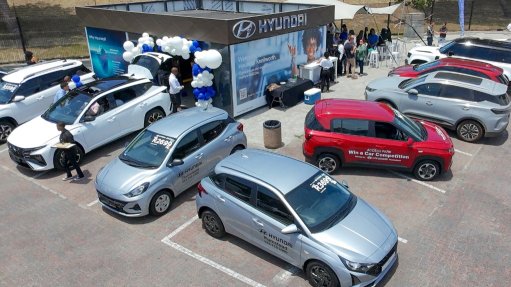LSFB creates faster, more economical construction
Developers, local authorities and housing associations are quickly embracing steel framing technology, such as light-steel-frame building (LSFB), says the International Zinc Association Africa Desk (IZA Africa Desk).
LSFB consists of structured wall panels, trusses and floor joists that are assembled using cold-formed steel sections, which, in turn, are made from thin-gauge, high-strength continuously galvanised steel sheet.
The galvanised steel sections used in LSFB are joined together in the factory using rivets or self-tapping screws to form structural wall panels and roof trusses for on-site erection on foundations and floor slabs.
Meanwhile, zinc is used extensively to galvanise steel to prevent corrosion.
Its energy efficiency, accuracy, resilient thermal properties, logistical cost advantages and design flexibility are making LSFB the building method of choice for a growing number of building types.
Further, LSFB entails less waste and shorter construction periods, which could offer cost savings of more than 20% compared with the conventional building method of using bricks and mortar, enthuses IZA Africa Desk representative Simon Norton.
In terms of cost efficiency, time savings are estimated to be more than 30%, compared with those of conventional building methods.
The steel frame itself also results in a higher degree of accuracy and squareness of building dimensions. A steel-framed wall clad with fibre cement or plasterboard offers a significant saving of 90%, compared with that offered by a so-called double-skin brick wall. The low mass of the walls also means that lighter foundations are possible, notes Norton.
Most LSFB manufacture takes place in factories and the off-site construction of components also contributes to the quicker turnaround time; the completed components are then transported and assembled on site.
“The typical life of an LSFB when using Z200 galvanised sheet is about 40 to 50 years, owing to the tenacity of the building envelope to keep out a corrosive atmosphere. Zinc generally corrodes at a low rate because of the protection offered by the resilient zinc patina formed by the reaction between the metallic zinc surface, the oxygen in the air and carbon dioxide,” Norton explains.
This compact, bonded and insoluble patina layer blocks exchanges between the atmosphere and the zinc.
Similar to timber-frame construction, the wall frames are clad externally and internally on site using a range of alternative cladding materials. Elements such as electrical cables, piping and insulation material are installed in the wall cavity.
Consequently, buildings can be occupied earlier for increased return on investment, as well as accurate cost budgets, he adds.
In addition, LSFB complies with the design requirements of the South African National Building Regulations.
Every structure is signed off by a structural engineer and only quality-certified materials are used. The frames are assembled under controlled factory conditions.
In the event of poor foundation conditions, LSFB buildings can accommodate some movement in foundations without cracking, as the LSFB method lends itself to column foundations and suspended floors, consequently reducing building cost at uneven sites.
Horizontal and vertical additions can be added easily in stages, with more floor space of up to 4%, owing to the reduced thickness of the external walls, compared with the space created by double-skin or cavity brick walls.
Zinc Link
Hot-dip galvanised substrate is produced on continuous zinc coating lines from either cold-rolled (thickness range 0.27 mm to < 2.0 mm) or hot-rolled (thickness 2.01 mm to 3.0 mm) steel substrate in coil form. It is produced to the requirements of EN 10142, EN 10147, EN 10143, ASTM A924, SANS 4998 or SANS 3575.
Looking at construction in general, zinc is used for applications such as rainwater systems, cladding and roofing, and alloyed with copper and titanium, Norton says. This combination of metals maximises tensile strength, malleability and load bearing capacity.
Zinc sheet and plate develops a natural patina when exposed to carbon dioxide-rich air. The patina protects the sheet metal from rust, salt and other natural forces. Zinc panels can last up to 50 years under the right conditions.
“Thermal insulation can be specified that is superior to conventional brick and mortar buildings, while professional finishes are readily achievable. The Southern African Light Steel Frame Building Association acts as a quality watchdog that accredits system-competent frame erectors and builders,” Norton concludes.
Article Enquiry
Email Article
Save Article
Feedback
To advertise email advertising@creamermedia.co.za or click here
Comments
Press Office
Announcements
What's On
Subscribe to improve your user experience...
Option 1 (equivalent of R125 a month):
Receive a weekly copy of Creamer Media's Engineering News & Mining Weekly magazine
(print copy for those in South Africa and e-magazine for those outside of South Africa)
Receive daily email newsletters
Access to full search results
Access archive of magazine back copies
Access to Projects in Progress
Access to ONE Research Report of your choice in PDF format
Option 2 (equivalent of R375 a month):
All benefits from Option 1
PLUS
Access to Creamer Media's Research Channel Africa for ALL Research Reports, in PDF format, on various industrial and mining sectors
including Electricity; Water; Energy Transition; Hydrogen; Roads, Rail and Ports; Coal; Gold; Platinum; Battery Metals; etc.
Already a subscriber?
Forgotten your password?
Receive weekly copy of Creamer Media's Engineering News & Mining Weekly magazine (print copy for those in South Africa and e-magazine for those outside of South Africa)
➕
Recieve daily email newsletters
➕
Access to full search results
➕
Access archive of magazine back copies
➕
Access to Projects in Progress
➕
Access to ONE Research Report of your choice in PDF format
RESEARCH CHANNEL AFRICA
R4500 (equivalent of R375 a month)
SUBSCRIBEAll benefits from Option 1
➕
Access to Creamer Media's Research Channel Africa for ALL Research Reports on various industrial and mining sectors, in PDF format, including on:
Electricity
➕
Water
➕
Energy Transition
➕
Hydrogen
➕
Roads, Rail and Ports
➕
Coal
➕
Gold
➕
Platinum
➕
Battery Metals
➕
etc.
Receive all benefits from Option 1 or Option 2 delivered to numerous people at your company
➕
Multiple User names and Passwords for simultaneous log-ins
➕
Intranet integration access to all in your organisation


















